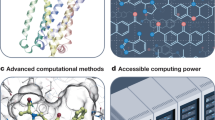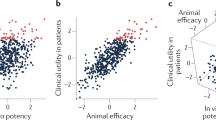Abstract
Computation promises to accelerate, de-risk and optimize drug research and development. An increasing number of companies have entered this space, specializing in the design of new algorithms, computing on proprietary data, and/or development of hardware to improve distinct drug pipeline stages. The large number of such companies and their unique strategies and deals have created a highly complex and competitive industry. We comprehensively analyze the companies in this space to highlight trends and opportunities, identifying highly occupied areas of risk and currently underrepresented niches of high value.
This is a preview of subscription content, access via your institution
Access options
Access Nature and 54 other Nature Portfolio journals
Get Nature+, our best-value online-access subscription
$29.99 / 30 days
cancel any time
Subscribe to this journal
Receive 12 digital issues and online access to articles
$99.00 per year
only $8.25 per issue
Buy this article
- Purchase on Springer Link
- Instant access to full article PDF
Prices may be subject to local taxes which are calculated during checkout






Similar content being viewed by others
Data availability
The data used for this analysis were retrieved from Cortellis (https://access.clarivate.com/login?app=cortellis) and Crunchbase (https://www.crunchbase.com/). Accounts with these providers are required to access their data. To ensure data availability for the work provided here, the curated data used to generate our figures and analysis are available on GitHub at https://github.com/RekerLab/ComputationalDrugRD and on Zenodo at https://doi.org/10.5281/zenodo.10482006 ref. 32.
Code availability
The code used to generate our figures and analysis are available on GitHub at https://github.com/RekerLab/ComputationalDrugRD and on Zenodo at https://doi.org/10.5281/zenodo.10482006 ref. 32.
References
Brown, N. et al. Artificial intelligence in chemistry and drug design. J. Comput. Aided Mol. Des. 34, 709–715 (2020).
Kopp, E. BioXCel Therapeutics announces FDA approval of IGALMI™ (dexmedetomidine) sublingual film for acute treatment of agitation associated with schizophrenia or bipolar I or II disorder in adults. BioXcel Therapeutics (6 April 2022).
Savage, N. Drug discovery companies are customizing ChatGPT: here’s how. Nat. Biotechnol. 41, 585–586 (2023).
Joachim, B., Rehm, W., Ryan, S. & Wright, P. A biotech survival kit for a challenging public-market environment. McKinsey (19 September 2022).
Leclerc, O., Suhendra, M. & The, L. What are the biotech investment themes that will shape the industry? McKinsey (10 June 2022).
Hodgson, J. 2022—toughing out the trough. Nat. Biotechnol. 41, 159–173 (2023).
Prieto-Martínez, F. D., López-López, E., Juárez-Mercado, K. E. & Medina-Franco, J. L. in In Silico Drug Design (ed. Roy, K.) 19–44 (Academic, 2019).
Mayr, A. et al. Large-scale comparison of machine learning methods for drug target prediction on ChEMBL. Chem. Sci. 9, 5441–5451 (2018).
Zhu, H. Big data and artificial intelligence modeling for drug discovery. Annu. Rev. Pharmacol. Toxicol. 60, 573–589 (2020).
Borhani, D. W. & Shaw, D. E. The future of molecular dynamics simulations in drug discovery. J. Comput. Aided Mol. Des. 26, 15–26 (2012).
Modulus discovery closes $20.4M USD Series C. Modulus (1 March 2022).
Jarvis, L. M. Relay Therapeutics launches to tackle protein movement. Chemical & Engineering News (14 September 2016).
Bell, J. Gilead taps into machine learning to find new NASH drugs. BioPharma Dive (16 April 2019).
Chory, E. J., Gretton, D. W., DeBenedictis, E. A. & Esvelt, K. M. Enabling high-throughput biology with flexible open-source automation. Mol. Syst. Biol. 17, e9942 (2021).
Ma, C., Peng, Y., Li, H. & Chen, W. Organ-on-a-chip: a new paradigm for drug development. Trends Pharmacol. Sci. 42, 119–133 (2021).
Reker, D. Practical considerations for active machine learning in drug discovery. Drug Discov. Today Technol. 32/33, 73–79 (2019).
Wadman, M. FDA no longer needs to require animal tests before human drug trials. Science 379, 127–128 (2023).
Hemmerich, J. & Ecker, G. F. In silico toxicology: from structure–activity relationships towards deep learning and adverse outcome pathways. Wiley Interdiscip. Rev. Comput. Mol. Sci. 10, e1475 (2020).
Baig, M. H. et al. Computer aided drug design: successes and limitations. Curr. Pharm. Des. 22, 572–581 (2016).
Bhardwaj, A. et al. Open source drug discovery—a new paradigm of collaborative research in tuberculosis drug development. Tuberculosis 91, 479–486 (2011).
Weingarten, M. D. E. Shaw Research licenses first-in-class therapeutic for immunological diseases to Lilly. D. E. Shaw Research (13 June 2022).
Hale, C. Schrödinger’s in-house pipeline helps fetch $2.7B molecule discovery deal with BMS. Fierce Biotech (18 January 2020).
Olleros, F.-J. Emerging industries and the burnout of pioneers. J. Prod. Innov. Manag. 3, 5–18 (1986).
Pagano, M., Panetta, F. & Zingales, L. Why do companies go public? An empirical analysis. J. Financ. 53, 27–64 (2002).
Eboli, M., Ozel, B., Teglio, A. & Toto, A. Connectivity, centralisation and ‘robustness-yet-fragility’ of interbank networks. Ann. Finance 19, 169–200 (2022).
Alexander, C. M. et al. Trends and perspectives of biological drug approvals by the FDA: a review from 2015 to 2021. Biomedicines 10, 2325 (2022).
Madura Jayatunga, L. B., Ludwig, R., Schulze, U. & Meier, C. in In Vivo (Pharma Intelligence, 2022).
Lajoie, J. M. & Shusta, E. V. Targeting receptor-mediated transport for delivery of biologics across the blood–brain barrier. Annu. Rev. Pharmacol. Toxicol. 55, 613–631 (2015).
Bender, A. & Cortés-Ciriano, I. Artificial intelligence in drug discovery: what is realistic, what are illusions? Part 1: Ways to make an impact, and why we are not there yet. Drug Discov. Today 26, 511–524 (2021).
Eisenstein, M. Active machine learning helps drug hunters tackle biology. Nat. Biotechnol. 38, 512–514 (2020).
AlphaFold and beyond. Nat. Methods 20, 163 (2023).
Markey, C. & Croset, S. ComputationalDrugRD. Zenodo https://doi.org/10.5281/zenodo.10482006 (2024).
Acknowledgements
This work was supported by the Duke Science and Technology Initiative and the NIH NIGMS grant R35GM151255 (D.R.). C.M. is supported by a Pratt Gardner Fellowship from the Duke Biomedical Engineering Department and by the NIH NIGMS Pharmacological Sciences Training Grant NIH T32 GM133352-4.
Author information
Authors and Affiliations
Contributions
C.M., S.C., C.K., D.K. and D.R. conceived the study and designed experiments. C.M. and S.C. conducted experiments. C.M., S.C., O.R.W., C.M.B, C.K., D.K. and D.R. analyzed the data. C.M., S.C., C.K., D.K. and D.R. wrote the manuscript. C.K., D.K. and D.R. supervised the work. All authors have read and approved the submitted version of the manuscript.
Corresponding authors
Ethics declarations
Competing interests
D.R. acts as a consultant to the pharmaceutical and biotechnology industry, as a scientific mentor for the German Accelerator, and serves on the scientific advisory board of Areteia Therapeutics. S.C., O.R.W., C.M.B., C.K. and D.K. are employees of Bellevue Asset Management and members of the investment team BB Biotech, with investments in the biotechnology industry including some of the companies analyzed here—a full list of the portfolio is available at https://www.bbbiotech.ch/ch-en/private/portfolio-strategy/performance-portfolio/our-investments.
Peer review
Peer review information
Nature Computational Science thanks Andreas Bender and the other, anonymous, reviewer(s) for their contribution to the peer review of this work. Primary Handling Editor: Kaitlin McCardle, in collaboration with the Nature Computational Science team.
Additional information
Publisher’s note Springer Nature remains neutral with regard to jurisdictional claims in published maps and institutional affiliations.
Supplementary information
Supplementary Information
Supplementary Tables 1–3 and Figs. 1–4.
Supplementary Data 1
The companies profiled in this analysis. The sheet shows the company reference list used to conduct the analysis. The data in the value matrix column refer to the type of advantage the company had. The letter indicates the R&D part and the digit the computational advantage. For the R&D component, the indexing is the following: A, modality; B, biology; C, delivery; D, safety; E, clinical; F, regulatory. For the computational advantage, the index is the following: 1, hardware; 2, dataset; 3, algorithm (XLSX 14 kb).
Supplementary Data 2
The projects analyzed in this paper. The sheet shows the most advanced projects in computational drug R&D company pipelines (XLSX 11 kb).
Rights and permissions
Springer Nature or its licensor (e.g. a society or other partner) holds exclusive rights to this article under a publishing agreement with the author(s) or other rightsholder(s); author self-archiving of the accepted manuscript version of this article is solely governed by the terms of such publishing agreement and applicable law.
About this article
Cite this article
Markey, C., Croset, S., Woolley, O.R. et al. Characterizing emerging companies in computational drug development. Nat Comput Sci 4, 96–103 (2024). https://doi.org/10.1038/s43588-024-00594-8
Received:
Accepted:
Published:
Issue Date:
DOI: https://doi.org/10.1038/s43588-024-00594-8



